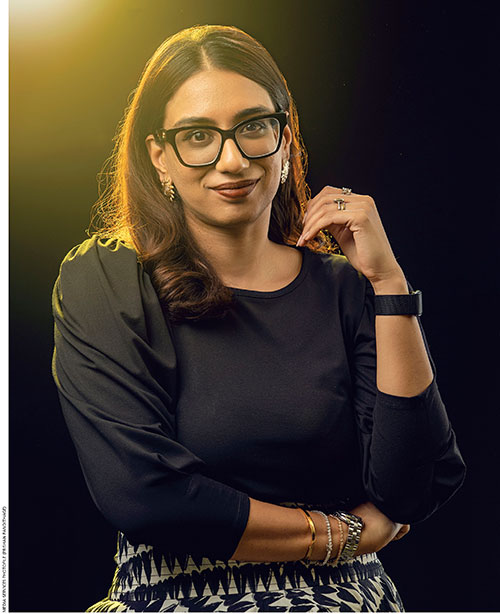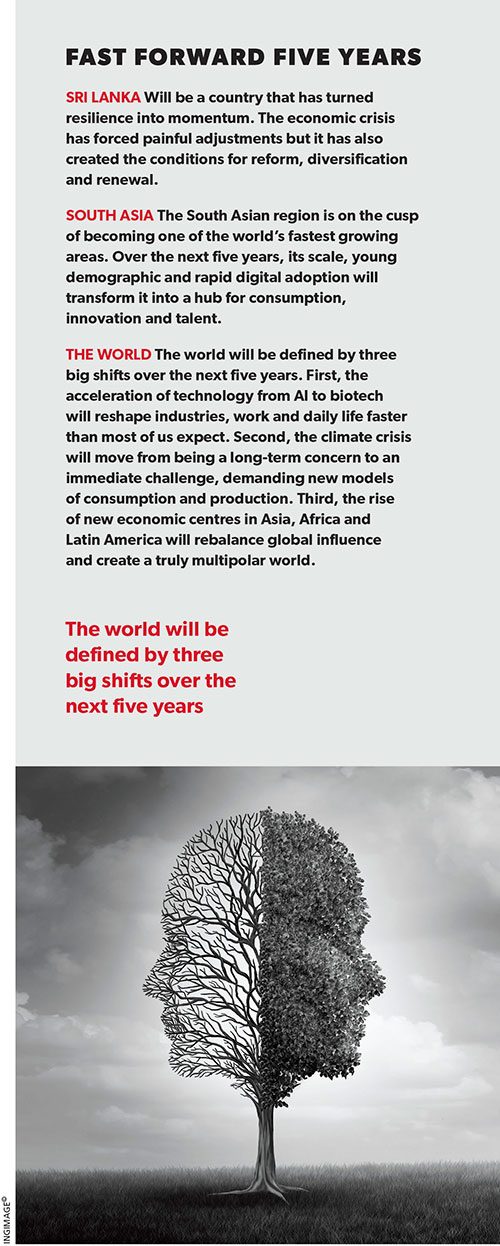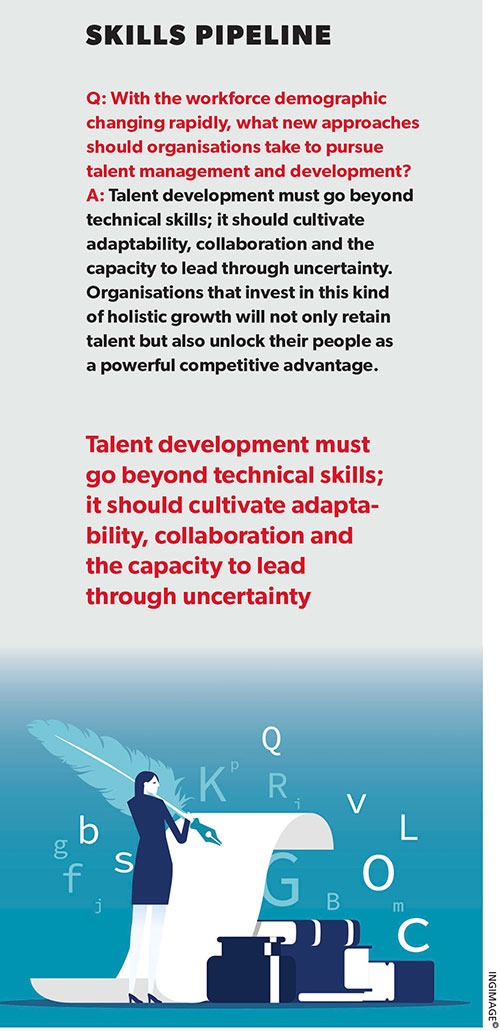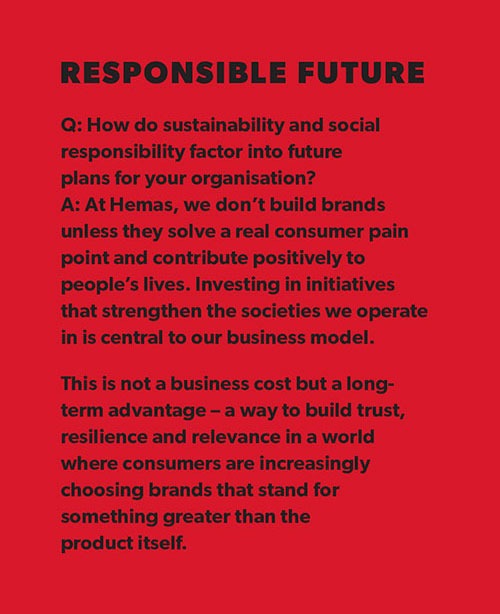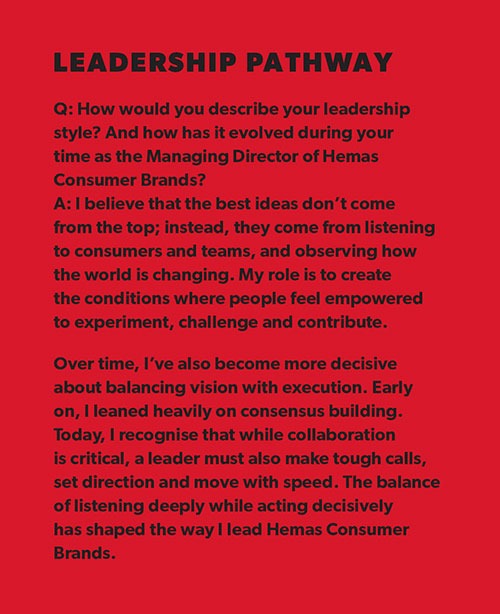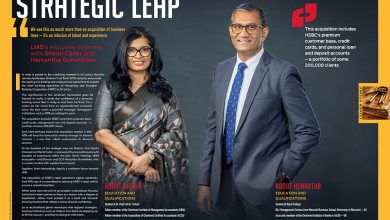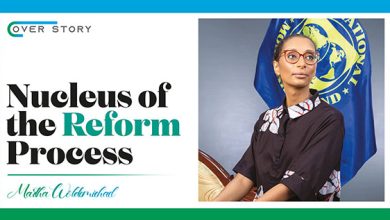LMD NOVEMBER 2025 COVER STORY

REDEFINING RELEVANCE
The only sustainable path forward is to place the consumer at the centre of the work, and create solutions that feel both personal and relevant
Sabrina Esufally
In a consumer world defined by speed and perception, few leaders succeed in aligning growth with purpose. Sabrina Esufally is one of them. As Managing Director of Hemas Consumer Brands, she steers many of Sri Lanka’s most trusted personal care, beauty and learning brands, across the island and in Bangladesh.
Against a backdrop of shifting regulatory, cultural and supply chain landscapes, she has demonstrated agility by embracing environmental, social, and governance (ESG) imperatives, driving sustainable pivots and shaping brand narratives that truly resonate.
Her academic journey reflects the same depth of commitment.
From the halls of Durham University, where she graduated with first class honours in law to the classrooms of Harvard Law School, she signals ambition. Along the way, she has worn many hats – beginning as Head of Legal Research at Verité Research, where she contributed to the public policy discourse before moving into the corporate sphere.
Esufally’s journey with Hemas began in 2019 when she joined the group as Head of Business Development at Morison – its pharmaceutical and OTC manufacturing arm. In 2020, she transitioned to Hemas Consumer Brands, where she drove portfolio growth and brand development in emerging categories, across beauty and wellness.
Since then, her leadership has been marked by a commitment to innovation with impact, building not only brands that sell but those that stand for something as well. From championing feminine hygiene initiatives and pioneering inclusive beauty to introducing parenting solutions that address real social needs, she has consistently tied product solutions to purpose.
Looking ahead, her sights are firmly set on the future and increasingly demanding markets, disruptive forces that challenge norms and consumer consumption in a fragile world. Her ambition is to build brands that do more than sell – brands that learn, evolve and connect with purpose.
– Compiled by Tamara Rebeira
If your consumer is changing faster than your brands, the end is inevitable
Q: Independent homegrown brands contributed nearly 40 percent of category growth in 2024 – a sharp increase from the year before. What consumer trends do you believe are driving this shift towards local brands and how should organisations adapt their strategies to meet these changing aspirations?
A: What we are witnessing today is a fundamental redefinition of aspiration. Consumers are no longer satisfied with one-size-fits-all choices. For many, progress now means being able to choose brands that celebrate where they come from, acknowledge their realities and address their pain points with precision.
This shift sends a clear signal to organisations: strategies can no longer be built around broad assumptions or imported playbooks. You can’t assume that what succeeds in a country such as Thailand would automatically do well here in Sri Lanka.
The only sustainable path forward is to place the consumer at the centre of the work, and create solutions that feel both personal and relevant.
Q: Sri Lanka’s economic challenges have seemingly changed buying habits. Consumers are now more value conscious and open to purchasing new products rather than necessarily sticking to old loyalties. In your view, what are the most notable shifts in consumer behaviour, following the economic crisis?
A: The economic crisis has fundamentally reshaped how Sri Lankan consumers think about spending. With incomes and savings under severe pressure, households were forced to make tough choices – i.e. downsizing their baskets, managing with less and prioritising price over brand or quality.
As the economy shows signs of stabilisation, consumers are not simply reverting to old habits – their priorities have shifted and they are making deliberate choices about where to allocate limited resources.
For instance, some consumers are choosing to spend more on mobile data than on household cleaning. Others prefer to spend more on eating out and compromising by delaying the completion of the construction of their home.
For businesses, this means the path to growth lies in understanding how consumer priorities have evolved. Success will come to those who meet consumers where their priorities are today – not where they were before the crisis.
Q: There’s been an evolution in perceptions whereby local products are being valued for their quality and desirability. How has this trend influenced how you position Hemas brands against multinational competitors?
A: Being a Sri Lankan organisation provides us the freedom to innovate directly for the emerging needs of local consumers. By contrast, multinationals often standardise their products and brands around larger focus markets – and Sri Lanka is rarely one of them.
At Hemas Consumer Brands, our approach has always been to adapt to global standards and trends in ways that are relevant and accessible at home. The balance of combining local insights with global quality makes our brands both relatable and aspirational.
Brands must be where their consumers are; and today, that means on smartphones and digital platforms
Q: With a legacy of over 70 years and armed with an impressive portfolio of heritage brands, Hemas continues to push for innovation. How do you balance maintaining the trust and legacy of longstanding brands with the need to modernise, reinvent and stay ahead of the curve?
A: If your consumer is changing faster than your brands, the end is inevitable. That’s why we make it our mission to stay ahead – whether it’s through the technology we use to build brands, the ability to read global trends or our deep understanding of local insights.
This forward focus enables us to honour the trust and legacy of our heritage brands while constantly evolving to meet new needs. Take baby care, for example: when we recognised how critical product safety had become for modern mothers, we invited them to collaborate with our scientists to define what safety standards meant to them.
That process of co-creation helped us raise the standard for safety in baby care, and ensure that our flagship brand Baby Cheramy continues to remain both trusted and relevant.
Q: Building brands today often requires engaging consumers in new ways. How important are digital engagement and bold storytelling in brand building – and what impact have they had on your brand portfolio?
A: Brands must be where their consumers are; and today, that means on smartphones and digital platforms.
However, digital engagement demands a very different mindset. It’s no longer about the perfectly curated ads; it’s more about the conversations that people have about your brand and the communities that form around it. When this is done properly, it creates loyalty that extends far beyond transactions.
At Hemas Consumer Brands, we are also leveraging digital to address real needs. A good example is Fio – Sri Lanka’s first trilingual period tracking app, which we developed to support women in managing their menstrual health.
Tools such as this strengthen the relationship between our brands and the people we serve, transforming us from being simply a product into becoming part of their everyday lives.
The greatest opportunity for women at work is to make it their mission to expand the market for other women


Q: You have said that you challenge yourself to create networks of women who support each other and celebrate one another’s success. How do you put this into practice at Hemas?
A: I believe that the greatest opportunity for women at work is to make it their mission to expand the market for other women.
At Hemas, that shows up in different ways – whether it’s through the products we innovate to make women’s lives easier, the teams we build that provide women the space to lead or the support networks we create to help them thrive.
Q: Globally, Gen Z employees are redefining the workplace as they seek flexibility, purpose and growth over traditional career ladders. How is Hemas evolving its workplace culture to attract and retain this new generation of talent? And what challenges does this phenomenon pose?
A: At Hemas, we have always believed that people do their best work when they have the freedom to innovate and experiment. For us, that means creating a culture where employees, regardless of their age or background, have the opportunity to solve real consumer challenges and watch their ideas come to life.
This philosophy naturally resonates with what Gen Z is looking for: purpose, growth and a voice at the table. The real challenge for organisations is to move beyond traditional hierarchies and truly empower young talent. At Hemas, it’s less about adapting to Gen Z specifically and more about shaping a culture that remains relevant to every generation.
Q: Looking ahead, what is your vision for Hemas Consumer Brands over the next five to 10 years?
A: My vision is for Hemas Consumer Brands to be recognised as the most innovative beauty and personal care company in frontier markets. Our goal is to build brands that not only set new standards of aspiration but also deeply understand and serve the evolving needs of our consumers.

